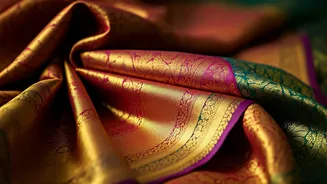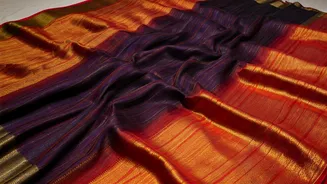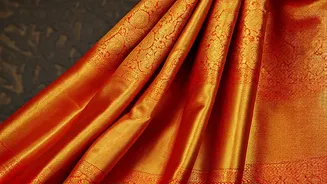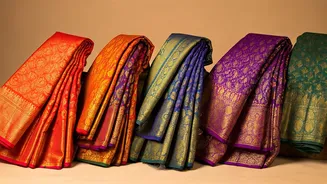Heritage of Weaving
Banarasi sarees, originating from the ancient city of Varanasi, are renowned worldwide for their extraordinary weaving techniques. The artistry involves
the use of silk and intricate zari work, where gold or silver threads are skillfully incorporated into the fabric. The legacy of these sarees dates back centuries, with each weave narrating a story of India's cultural richness. The designs often showcase Mughal-inspired motifs, adding to their regal appearance, and are meticulously crafted by skilled artisans who have honed their craft over generations. The quality of silk is a crucial factor, chosen for its lustrous texture and ability to accept the rich dyes used in the process. The complexity in the patterns and designs can require several days, sometimes even weeks, to complete a single saree, emphasizing their value and the weaver's dedication.
Artistry and Craftsmanship
The creation of a Banarasi saree is a painstaking process, requiring a fusion of skill and time. The journey begins with the selection of the finest silk yarns, meticulously dyed to vibrant hues, setting the foundation for the visual splendor of the saree. Artisans employ various techniques like 'kadwa' weaving, where each motif is individually woven, contributing to the saree's intricate look. Another significant feature is the use of 'zari' work, where metallic threads, often real gold or silver, are woven to create elaborate patterns. The borders and 'pallus' (the decorative end piece) are frequently adorned with heavy zari, showcasing complex designs. The patterns draw inspiration from Mughal-era motifs, including floral patterns, paisley, and geometric shapes, each reflecting the historical and cultural influences.
Bridal Wear Significance
Banarasi sarees hold immense significance in Indian weddings, especially for brides, being a symbol of grace, tradition, and prosperity. The rich textures, vibrant colors, and elaborate designs make them ideal for bridal wear, reflecting the festive and auspicious nature of the occasion. The intricate zari work and opulent appearance are deemed perfect for the central figure of the wedding. Brides often choose these sarees for their wedding day, viewing them as heirloom pieces. The sarees are paired with complementary jewelry and accessories, creating a cohesive and stunning look. They are often passed down through generations, becoming cherished family treasures, carrying forward the legacy of weddings and family memories.
Variety of Styles
The diverse range of Banarasi sarees offers a style for every bride, each design representing a distinct approach to artistry. The Divastri Banarasi saree is known for its intricate detailing and luxurious feel, often incorporating fine zari work and delicate motifs. Mukhita Kanjeevaram sarees display a different style, known for their vibrant colors and bold designs, often with contrasting borders. Zari Dharmavaram sarees, with their detailed craftsmanship, present an alternative choice, featuring distinctive patterns and textures, created by skilled weaving. Each style provides a unique expression of traditional craftsmanship, ensuring that a bride can find a saree that perfectly reflects her individuality. These sarees also differ in the amount and type of zari work used, the complexity of the patterns, and the weight of the fabric, offering various options to meet different preferences and budgets.
Caring for Sarees
Preserving the beauty and longevity of a Banarasi saree demands careful attention and appropriate care. To retain the saree's original sheen and texture, it is advisable to dry clean these luxurious garments. During storage, one must ensure the sarees are kept in a cool, dry place, away from direct sunlight and humidity. They should be folded correctly, using acid-free tissue paper between the folds to prevent the zari work from snagging and to maintain the saree's shape. Avoiding direct exposure to perfumes and strong chemicals is also crucial, as these substances can damage the delicate threads and dyes. With proper care and attention, a Banarasi saree can be preserved for several years, becoming a treasured heirloom to be cherished for generations.










